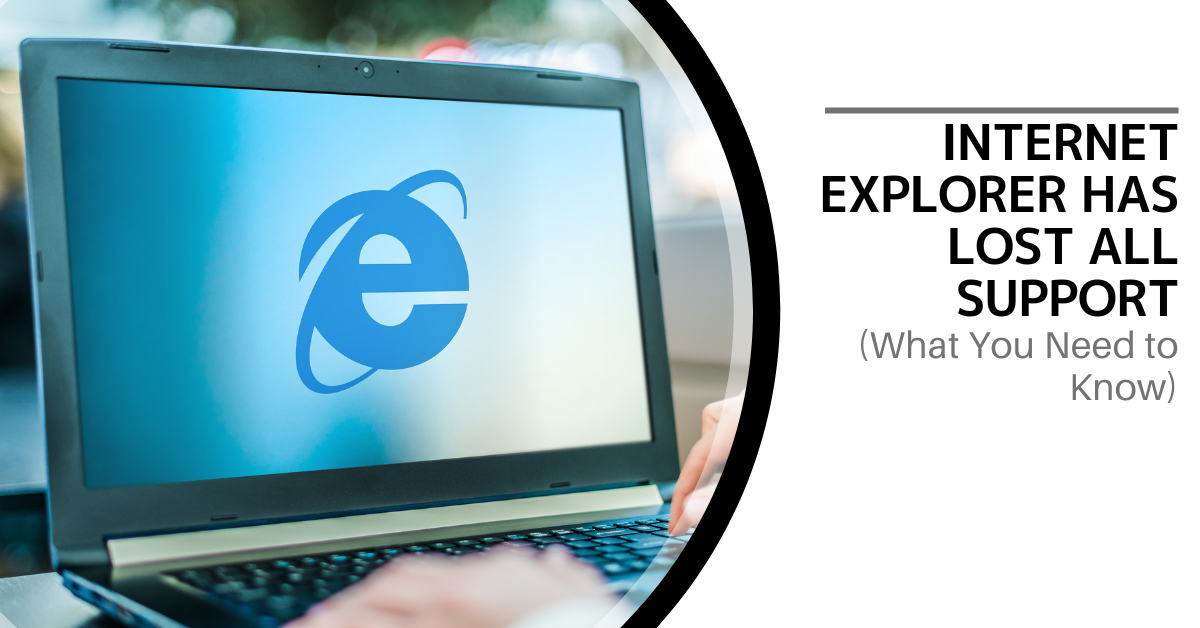After being the main window to the internet in the late 90s and early 00s, Internet Explorer (IE) is gone. Like seriously – gone gone. As of June 15, 2022, Microsoft dropped the web browser from support (no but seriously, who has been using it anyways?)
IE released in the age of connection to the world in 1995 and for many years held a majority of the browser market share. With the release of newer, more relevant browsers (like Google Chrome) made it less appealing to users.
In 2014, Internet Explorer still held about 59% of the global market share. Google Chrome came at 21%. Just two years later, IE lost its top spot to Google product and fell behind another newcomer, Safari.
Microsoft realized, that outdated browser won’t last with this competition and in 2015 Microsoft released a new browser, Edge. From the start, Edge was destined to take IE’s place as the official browser installed on Windows systems.
It’s inevitable, the longer technology is driving work and home life, that we’re going to lose some of our favourites. Adobe Flash Player is another technology that used to be widely used and is now gone. Who doesn’t love those Flash animations all over the web?
So, now that IE has reached its end of life (EOL), what is next?
IE Mode in Edge
To ease the transition away from Internet Explorer, Microsoft added IE Mode to Edge browser. This mode will allow organizations to still use legacy sites that may have worked best in IE. It uses the Trident MSHTML engine from IE11 to make it possible.
When in IE mode, you’ll still see the Internet Explorer icon on your device. But if you open it, you’ll actually land in Microsoft Edge
Internet Explorer Icons to be removed in the Future
Microsoft isn’t getting rid of the IE icons just yet. Those will still appear in the taskbar and Start menu on Windows. But in near future users can expect to see those removed.
Edge Will Import Data from IE
All your favourites, saved passwords, and settings that you have in IE, can be imported easily in Microsoft Edge, so they’re not lost. This will include things like your browsing history and other data stored in the browser. You’ll then be able to access these in the Microsoft Edge’s settings area.
What Do You Need to Do Now?
Uninstall the Browser
It’s always risky to keep older technology that is no longer supported on your system. Cybercriminals very often use those to exploit that and use older tools that are not receiving any security updates. This leaves an open invitation to breach your PC and network. Manufacturers are never going to address these as Microsoft retired the software.
Outdated technology costs enterprises approximately 47% more when they suffer a data breach. As compared to those with updated tools.
You should transition your stored information to Microsoft Edge (or another trusted browser). Then uninstall IE from your devices.
Ensure Employees Know How to Use IE Mode in Edge if needed
Of course you want to avoid is what happened to many organizations in Japan, where several government and corporate websites weren’t prepared for the retirement of IE.
It was reported that IT and engineering departments received many calls for help. Although it came with warnings, it still, was a shock to many that used legacy sites that need IE to work. This included the customers of government agencies, financial institutions, and other organizations or businesses.
This left them scrambling to try to figure out what to do at the last minute. They still needed access to different online management portals, and other online.
Of course, with IE mode in Edge, this transition didn’t need to be so chaotic. But without communication or training, more than 20% of still affected users hadn’t figured out what to do.
Make sure you communicate with your team what to do. Companies can automate IE mode for their users so that it launches automatically.
Microsoft Edge Features – Train your users
Microsoft Edge has a lot of benefits over IE and many other browsers. It’s faster and more responsive than Internet Explorer. It also has comprehensive security controls (password breach monitoring is a handy tool).
But with all new tools, if you want employees to use them proficiently, they need to have a chance to learn, so take the time to transition right, and have your employees trained.
Need Help Upgrading Your Digital Tools?
You don’t have to panic when a technology you and your business use retires. We can help you upgrade well ahead of any deadlines. Reach out today to schedule your current technology consultation.


Comments are closed